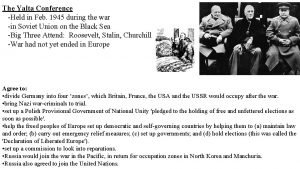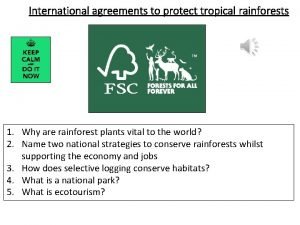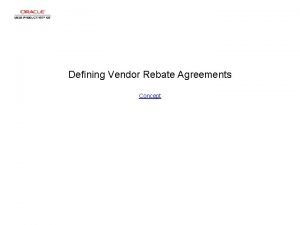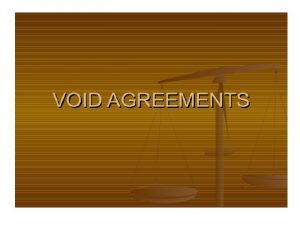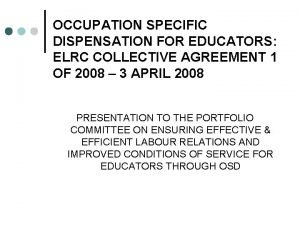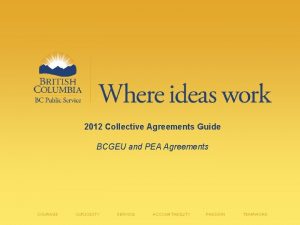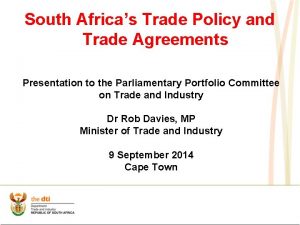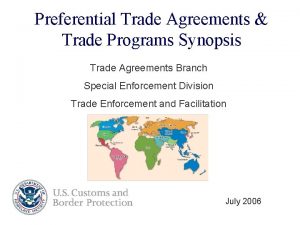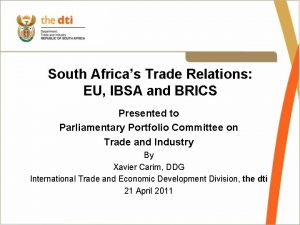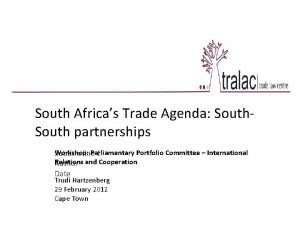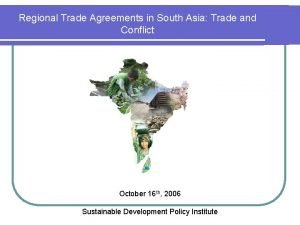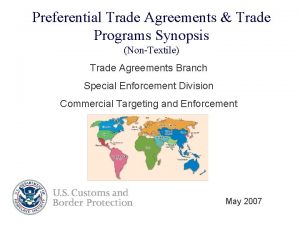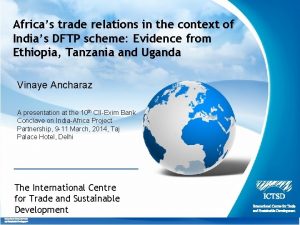South Africas trade agreements and relations trade matters












- Slides: 12

South Africa’s trade agreements and relations: trade matters for the 21 st century? Trudi Hartzenberg (trudi@tralac. org) Portfolio Committee on Trade and Industry 1 August 2013

Overview • 21 st century trade – implications for trade policy • South Africa’s trade policy agenda • Select issues for an RTA agenda: services, nontariff measures, trade remedies, safeguards and standards

Global developments – 20 th century • Industrial restructuring (relocation of industry – clusters of excellence in developing countries) • Trade in goods (finished products) Trade governance: WTO agenda (tariffs matter), much less successful in services liberalisation and the development of a new trade agenda (recall Singapore issues…. )

21 st century trade • • • Global value chains: fragmentation of production processes - coordination efficiencies Trade in intermediates, services (role of services in manufacturing competitiveness, increase in services trade) Role of consumers – standards, intellectual property… Trade governance – modern Free Trade Agreements Mega-trade deals – eg TPP, EU-US, EU-Canada, Japan-EU, Canada-Japan, covering: - behind the border disciplines/rules, regulation, investment governance, beyond TRIPs, Trade remedies, Customs cooperation, GATS, movement of capital Quality of government, governance matters

South Africa’s trade strategy framework NOTE: South Africa is a member of the Southern African Customs Union (SACU) Trade policy development: • Trade Policy Strategy Framework (2010, revised October 2012), New Industrial Policy Framework (and IPAPs) • National Development Plan (November 2011, revised late 2012) • New Growth Path (2010) an ndustrial strategy? Reference to: • Integration into the global economy • Regional integration (Africa-focus) • South-South relations How does this translate into a trade policy strategy?

In brief: i) Import tariff as an instrument of industrial policy ii) Strategic tariff policy is the cornerstone of South Africa’s trade policy iii) Predominant focus on manufacturing/trade in goods (what about services? Investment? ) iv) Use tariff policy space (announcement early 2013 by Trade Minister) v) Export taxes South Africa’s use of trade remedies (anti-dumping) Where is the services agenda? Political economy of trade policy making • Domestic political economy game • Global trade strategy (multilateral/regional/bilateral) • Still strong focus on multilateral, rather than regional trade strategy Inward-looking strategy/defensive

South Africa’s trade relations, agreements • SA’s trade agreements: EU (TDCA) – EPA negotiations, SACU-MERCOSUR (not in force yet) • Trade negotiations (ongoing): SACU-India • RSA-US relations (AGOA – unilateral preferential market access), an FTA? • Japan (they requested SACU to negotiate an FTA)

Looking Ahead: Select issues for a modern RTA agenda – where can SA focus? Services matters • Contribution to GDP (approx 65%) • Producer services – transport, communications, finance, distribution, business are inputs into almost everything, and significant determinants of the productivity of capital and labour • Services in trade (tradeable) • Services in trade facilitation • Linkages among services (communication – education)

Non-tariff measures (to Non-tariff barriers? ) • Moving beyond the simple policy substitution story between tariffs and quantitative restrictions • Governments employ NTMs to achieve public policy objectives: – Protection of public health, safety, scarce resources, environment – National security • Public policy concerns have increased, leading to more complex (in nature and variety) NTMs used by governments • The expansion of the policy agenda means that NTMs will not reduce in relevance like tariffs have done… • NTMS can become NTBs How to develop a rules-based system to eliminate NTBs (not legitimate NTMs)?

Trade Remedies, Safeguards and Standards Examples of current issues: Chicken (anti-dumping – Brazil) and Chips (safeguards – Belgium, the Netherlands) Canned peaches (safeguard – Australia) Citrus: black spot (SPS issue)

Rules of Origin • Determine the national origin of a product • Role: to prevent trade deflection • However, Ro. O can also be used as an industrial policy instrument (this will negate liberalisation efforts)

Defining a new trade-industrial policy agenda Trade in services agenda • Connectivity: infrastructure, ICT, competitive key services Enhancing the business environment • Ease of doing business e. g. business registration regulations, contract enforcement, import export documentation, improved transparency + promotion of entrepreneurship • Trade facilitation • Focus on innovation, R&D and science and technology policy. • International rule setting – harmonisation of rules, standards, mutual recognition of standards/qualifications
 Whats africas largest lake
Whats africas largest lake Employee relations in public relations
Employee relations in public relations Old south vs new south streetcar named desire
Old south vs new south streetcar named desire Pie expanding strategies
Pie expanding strategies Yalta conference agreements
Yalta conference agreements Unanimous agreements
Unanimous agreements International hardwood agreements
International hardwood agreements Supplier rebate agreement
Supplier rebate agreement Uncertain event meaning
Uncertain event meaning The four agreements preview
The four agreements preview Elrc collective agreements
Elrc collective agreements Long-term parts agreements
Long-term parts agreements Pea collective agreement
Pea collective agreement




